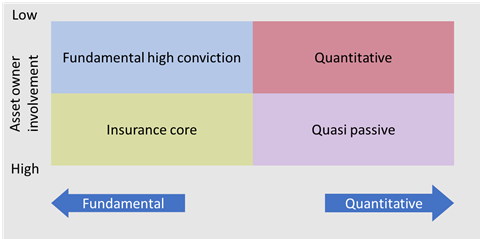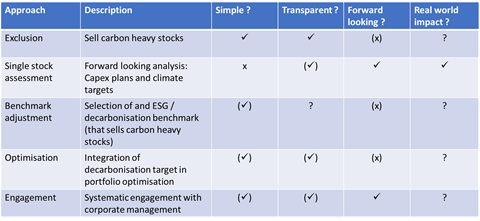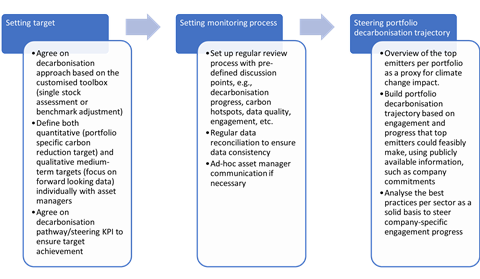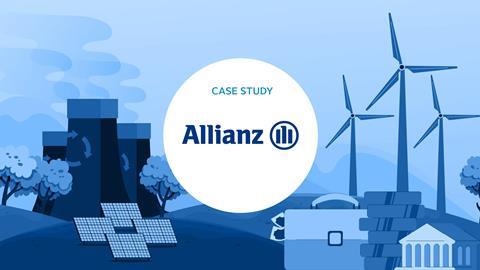Allianz Investment Management SE
Signatory type: Asset owner
HQ location: Germany
Region of operation: Europe
Covered in this case study
Asset class: Listed equity
AUM: approximately €40bn in listed equities
We are one of the world’s largest insurers and financial services groups. Our core businesses are insurance and asset management.
Why a differentiated decarbonisation approach is needed
After becoming a signatory of the UN Net-Zero Asset Owner Alliance in 2019, Allianz submitted its first interim targets aiming to reduce Scope 1 and 2 greenhouse gas emissions by 25% by the end of 2024 (baseline year 2019) for listed equity and corporate bonds.
A differentiated approach to implementation was needed, given the different degrees of freedom permitted portfolio managers and the large number of stocks invested in across Allianz’s equity portfolio strategies (see Figure 1).
Figure 1: Different investment approaches require differentiated decarbonisation approaches

The insurance core strategy is designed to meet long-term liability-driven investment targets under insurance constraints while achieving a certain degree of benchmark outperformance. This being a core strategy, the asset owner involvement is high.
Both the fundamental high conviction and quantitative strategies are characterised as satellite strategies for alpha generation within a certain tracking error budget. Compared with the insurance core strategy, internal and external asset managers of satellite strategies usually have more leeway in portfolio construction. And while the fundamental high conviction strategy focuses on bottom-up stock picking based on a company’s perceived intrinsic value using its fundamental data, the quantitative strategy constructs portfolios using a computer-based model to gain desired factor exposures and manage risk levels. The key difference is that the quantitative strategy does not look at individual stocks, but instead optimises against multiple portfolio factor exposures.
The fourth category is the quasi-passive strategy, which tracks a benchmark with minimal tracking error. By design, asset managers have less freedom to deviate from the benchmark and the number of holdings would be close to that of the benchmark. It maintains some alpha potential within limited tracking error budget with insurance constraints. This being a core strategy, the asset owner involvement is high.
How to achieve our net-zero target with real-world impact on an aggregate portfolio level
There are a number of approaches to steer the Allianz equity portfolios towards our net-zero target. Figure 2 shows how they fit in with the above investment approaches, this time in the context of backward-looking vs forward-looking attributes. The quant and quasi-passive strategies on the right are implemented using standardised techniques while the fundamental and insurance core strategies on the left rely much more on use of judgement to reach investment decisions. Figure 3 provides a summary of the approaches.
Figure 2: Customised de-carbonisation toolbox for total portfolio steering

Figure 3: Five approaches to advancing a net-zero target

Option I: Exclusion is the most straightforward way to achieve our net-zero target, however with an obvious drawback of relying on backward-looking data. This approach is suitable for managing downside risks (stranding risks), but not for accessing climate-related opportunities. Excluding companies with a solid commitment to the climate transition, whose efforts have not been fully realised yet, contradicts Allianz’s commitment to achieving real-world impact. Thus, we only consider it as a contingent measure.
Option 2: For fundamental strategies with relatively few names in the portfolio and relying on asset managers’ skills in active stocking picking, integration of a carbon target into single stock assessment is the best fit. This approach mostly leverages asset managers’ expertise to identify climate solution-based companies while maintaining the current risk-return profile. Another advantage of this approach is that forward-looking measures are being integrated into the stock valuation model and could be steered through promising engagement. However, due to resource constraints, this approach is not scalable.
Option 3: Changing to a low-carbon benchmark would be a potential solution for strategies which closely track the benchmark (e.g., quasi passive / passive, or active quantitative strategy with an ambitious decarbonisation target). The choice of benchmark depends on three criteria: 1) target level, 2) existing exclusions, and 3) existing KPIs, such as risk-adjusted returns and insurance-specific constraints – including solvency ratio, risk capital and volatility. The potential drawback with this approach is the quality of forward-looking data. Although most benchmark providers claim they apply forward-looking assessments in the benchmark’s construction, methodologies are often not fully transparent yet, and it is sometimes the case that the data have little predicting power for future improvement. Another side effect is increasing basis risk for hedging, as availability of ESG/climate derivatives remains limited.
Option 4: Quantitative optimisation. Adding a decarbonisation target into the factor model could potentially work for an active quantitative strategy, assuming the addition does not change factor exposures materially. In cases where the portfolio is optimised against a benchmark, a regular liaison would be needed with the designated asset manager to determine if changing to a low-carbon benchmark is necessary to achieve the long-term decarbonisation target. This approach faces the same problem as option 1, i.e., data used in the optimisation process relies heavily on backward-looking emissions.
Option 5: Engagement. As the key for ensuring long-term target achievement, engagement should be integrated into all the above options as well as the whole investment process.
Example: Steering our fundamental equity portfolio towards our net-zero target
For the fundamental equity strategy, asset managers investigate within their existing portfolio how fundamental research and active investment choices can be optimised to manage climate risk exposure/opportunities. This means minimising climate risk/maximising climate opportunity in a portfolio context, i.e. stock picking/portfolio rebalancing. In addition, engagement and proxy voting strategies are employed to improve the performance of selected companies whose business models are exposed to climate transition risks. The portfolio decarbonisation approach/target is agreed individually with portfolio managers based on the starting point of the portfolio and the decarbonisation ambition level. To ensure target achievement, an additional sustainable KPI, including both ESG and climate aspects, is added into the existing KPI framework, which includes insurance-specific constraints related to the solvency ratio and risk capital. Decarbonisation progress is reviewed on a regular basis with pre-agreed focus topics. This portfolio trajectory steering process is essential to track overall portfolio net-zero alignment.
For the fundamental and quantitative strategies, we use the following levers to allocate new capital and reallocate existing capital towards achieving our long-term net-zero target:
- Exclude or divest from companies with stranding risk and/or that fail to show proven climate change mitigation/adaption responses to short-term policy/reputation risks, medium-term market and technology risks of climate transition, long-term chronic physical climate risks;
- Reduce portfolio aggregate climate risk exposures by tilting towards companies with convincing commitment/pathway to net-zero alignment;
- Increase portfolio exposure to climate solution providers.
Engagement is key to ensuring our portfolio is moving in the right direction over time.
Figure 4: Target setting process for active fundamental strategy

Find out how other investment managers and asset owners implemented net-zero commitments in listed equity portfolios in our report, Net zero in practice: Insights from equity investors.












